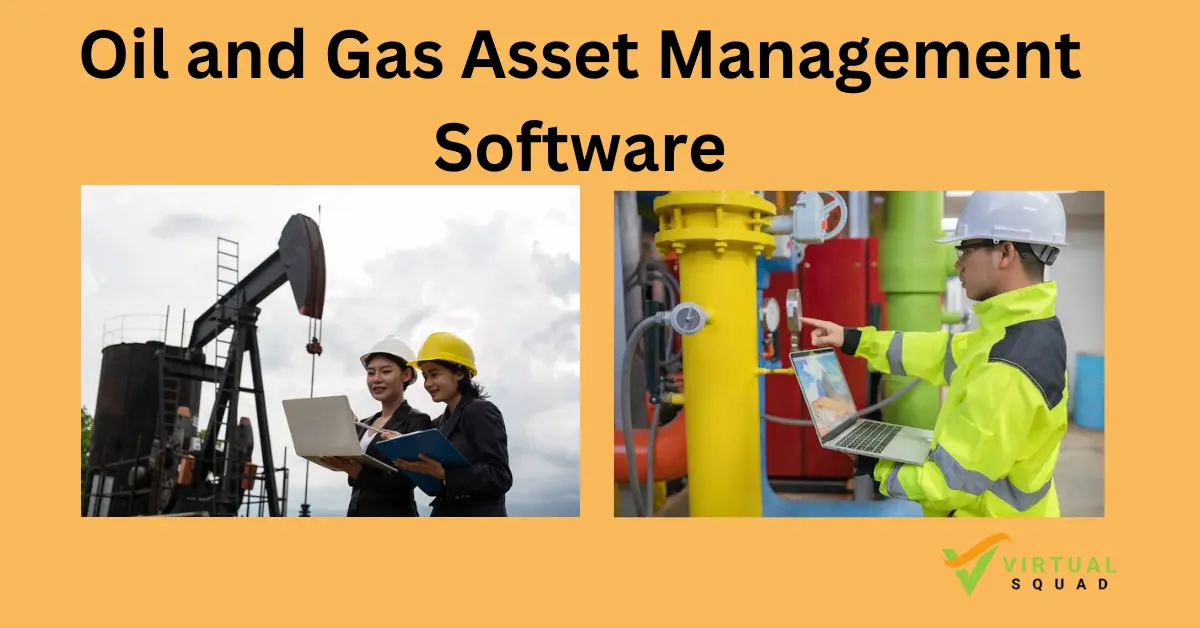The oil and gas industry operates in a complex and dynamic environment, managing vast and valuable assets across multiple locations. Oil and gas companies increasingly turn to asset Oil and Gas Modeling Solutions to efficiently handle royalty management, production optimization, and strategic decision-making. This article explores the best oil and gas asset management software, focusing on royalty, production, and modeling software. By automating processes, providing real-time data analysis, and enhancing communication, these software solutions offer numerous benefits for the industry. This article will delve into the key features, benefits, selection factors, and future trends of oil and gas asset management software, along with real-world case studies highlighting successful implementation.
1. Introduction to Oil and Gas Asset Management Software

1.1 Understanding the Importance of Asset Management in the Oil and Gas Industry
Managing assets in the oil and gas industry is a challenging task. With complex operations and valuable resources at stake, companies need effective solutions to optimize their asset management processes. That’s where oil and gas asset management software comes in. This technology helps companies track, analyze, and control their assets to maximize efficiency and profitability.
1.2 Overview of the Role of Software in Efficient Asset Management
Gone are the days of relying on spreadsheets and manual record-keeping. Oil and gas asset management software streamlines and automates various tasks, such as tracking production, calculating royalties, monitoring equipment, and analyzing data. By centralizing all crucial information in one place, software solutions make it easier for companies to make informed decisions, reduce errors, and increase overall productivity.
2. Key Features and Benefits of Royalty Management Software

2.1 Automating Royalty Calculations and Payments
Calculating royalties is a time-consuming and error-prone process. Oil & Gas production software takes the burden off your hands by automating these calculations based on predefined rules. It ensures accurate and timely payments to mineral owners, eliminating the risk of disputes and penalties.
2.2 Streamlining Compliance and Reporting Processes
Compliance with regulatory requirements is crucial in the oil and gas industry. Royalty management software simplifies the process by generating reports that meet industry standards, making it easier to stay compliant. It also keeps track of lease and contract terms, ensuring that your operations align with legal obligations.
2.3 Enhancing Communication and Transparency with Stakeholders
Maintaining strong relationships with stakeholders, such as mineral owners and partners, is essential. Oil and Gas Accounting Software provides a platform for transparent communication, allowing stakeholders to access real-time data on their royalty payments, production volumes, and more. This fosters trust and improves overall collaboration.
3. Enhancing Production Efficiency with Asset Management Software

3.1 Real-Time Monitoring and Data Analysis for Improved Production Management
Effective production management requires real-time monitoring and analysis of key performance indicators. Asset management software provides insights into production volumes, equipment performance, and operational metrics, enabling companies to identify bottlenecks, make data-driven decisions, and optimize production processes.
3.2 Optimizing Maintenance and Preventive Strategies
Equipment failure can be costly and lead to significant downtime. Oil and Gas Assessment, a management software download, helps companies implement proactive maintenance strategies by tracking equipment performance, scheduling maintenance tasks, and predicting potential issues. By preventing breakdowns and reducing unplanned downtime, companies can maximize production efficiency.
3.3 Tracking and Managing Equipment and Inventory
Efficient asset management entails keeping track of equipment and inventory. Asset management software provides a centralized database where companies can monitor equipment utilization, track maintenance history, and manage inventory levels. This helps streamline operations, minimize inventory costs, and ensure the availability of critical resources.
4. Utilizing Modeling Software for Accurate Decision Making

4.1 Forecasting and Predictive Analysis for Production Planning
Accurate production planning is crucial for optimizing operations and meeting demand. Modeling software utilizes historical data and advanced forecasting techniques to predict future production volumes and optimize supply chain management. This enables companies to make informed decisions, such as adjusting production schedules or identifying new market opportunities.
4.2 Reservoir Modeling for Improved Resource Management
Efficient resource management starts with understanding the characteristics of reservoirs. Modeling software helps oil and gas companies simulate reservoir behavior, estimate reserves, and optimize extraction strategies. By gaining insights into reservoir dynamics, companies can optimize drilling plans, reduce costs, and maximize resource recovery.
4.3 Simulation and Scenario Analysis for Risk Assessment
In an industry prone to uncertainty and risk, making informed decisions is crucial. Modeling software allows companies to perform scenario analysis and simulate different operational scenarios. By assessing the impact of various factors, such as oil price fluctuations or equipment failures, companies can identify potential risks and develop contingency plans to mitigate them.
So, whether it’s automating royalty calculations, optimizing production processes, managing equipment, or making accurate decisions based on modeling, oil and gas asset management software is a game-changer for the industry. It’s time to embrace these technological advancements and unlock the full potential of your assets.
5. Factors to Consider When Choosing Oil and Gas Asset Management Software

When selecting oil and gas asset management software, several factors must be considered. Here are three important ones:
5.1 Scalability and Customization Options
Oil and gas operations come in all shapes and sizes, so choosing software that can scale with your needs is crucial. Look for a solution that allows for easy customization so you can tailor it to fit your specific requirements. After all, the last thing you want is software that feels uncomfortable and restrictive, like an ill-fitting pair of jeans.
5.2 Integration with Existing Systems
Integrating new software into your existing systems can be a headache. That’s why it’s essential to choose a solution that plays well with others. Ensure the software you select seamlessly integrates with your current infrastructure, saving you time and effort. You want to avoid ending up with software that’s as compatible as oil and water.
5.3 User-Friendliness and Training Requirements
Let’s face it, not everyone in the oil and gas industry is a tech whiz. So, it’s important to choose user-friendly software that doesn’t require a Ph.D. in computer science to operate. Look for intuitive interfaces and thorough training resources to ensure a smooth transition for your team. After all, you don’t want your employees feeling as lost as drill bits in a haystack.
6. Case Studies: Successful Implementation of Asset Management Software

Nothing speaks louder than success stories. Here are two case studies showcasing the benefits of implementing oil and gas asset management software:
6.1 Company A: How Asset Management Software Improved Production and Cost Efficiency
Company A, a major oil and gas producer, implemented asset management software and experienced a significant boost in production and cost efficiency. The software streamlined workflows, allowing for better planning and resource allocation. As a result, Company A saw a considerable reduction in downtime and operational costs, leaving their competitors green with envy.
6.2 Company B: Enhancing Royalty Management and Compliance with Software Solution
Company B, an up-and-coming player in the industry, struggled with royalty management and compliance. However, after implementing asset management software, they could effectively track and manage their royalty payments and ensure compliance with regulatory requirements. The software provided them with accurate data and automated processes, saving them from the tedious task of sifting through endless spreadsheets. Company B’s newfound efficiency left their competitors scratching their heads and wondering how they managed to strike black gold.
7. Future Trends in Oil and Gas Asset Management Software

The world of oil and gas asset management software is constantly evolving. Here are a few future trends to keep an eye on:
7.1 Adoption of Artificial Intelligence and Machine Learning Technologies
Artificial intelligence and machine learning have the potential to revolutionize oil and gas asset management. These technologies can analyze vast amounts of data, identify patterns, and suggest optimized strategies. So, don’t be surprised if your asset management software starts giving you advice like a helpful drilling buddy.
7.2 Integration of Internet of Things (IoT) for Real-Time Monitoring
The Internet of Things (IoT) is making its way into the oil and gas industry, enabling real-time monitoring of assets. With IoT integration, your asset management software could provide you with up-to-the-minute data on equipment performance and maintenance needs, helping you prevent costly breakdowns and keep production flowing like a well-oiled machine.
7.3 Advancements in Data Analytics and Visualization
Data analytics and visualization tools are becoming increasingly sophisticated in the oil and gas sector. Advanced algorithms and eye-catching visualizations can help you make sense of complex data sets, allowing for better decision-making and a clearer view of your assets. Get ready to see dashboards that are as stunning as a Texas sunset.
8. Conclusion and Recommendations for Implementing Asset Management Software
In conclusion, oil and gas asset management software has become a crucial tool for companies in the industry. By leveraging the capabilities of royalty, production, and modeling software, organizations can streamline their operations, improve decision-making, and enhance overall efficiency. When selecting the right software solution, factors such as scalability, integration, and user-friendliness should be carefully considered. With the continuous advancements in technology, the future of asset management software in the oil and gas industry looks promising, with the integration of artificial intelligence, IoT, and advanced data analytics. Implementing these software solutions can provide a competitive edge and unlock new opportunities for success in the ever-evolving oil and gas landscape.
FAQ
1. What is oil and gas asset management software?
Oil and gas asset management software is a specialized software solution designed to help companies in the industry efficiently manage their assets, including royalties, production data, and modeling. It automates processes, provides real-time data analysis, and enhances communication, ultimately improving operational efficiency and decision-making.
2. How can asset management software benefit oil and gas companies?
Asset management software offers several benefits to oil and gas companies. It enables automated royalty calculations and payments, streamlines compliance and reporting processes, enhances production efficiency through real-time monitoring and data analysis, optimizes maintenance and preventive strategies, and aids in accurate decision-making through forecasting, modeling, and simulation.
3. What should be considered when selecting oil and gas asset management software?
Factors such as scalability, customization options, integration with existing systems, and user-friendliness should be considered when choosing asset management software. Additionally, the software should align with the specific needs and objectives of the organization, and adequate training and support should be available to ensure a smooth implementation process.
4. What are the future oil and gas asset management software trends?
The future of asset management software in the oil and gas industry is likely to witness the adoption of artificial intelligence and machine learning technologies for advanced analytics and decision-making. Integration of the Internet of Things (IoT) for real-time monitoring and data collection is also a growing trend. Furthermore, advancements in data analytics and visualization capabilities will continue to offer valuable insights for operational and strategic management.






